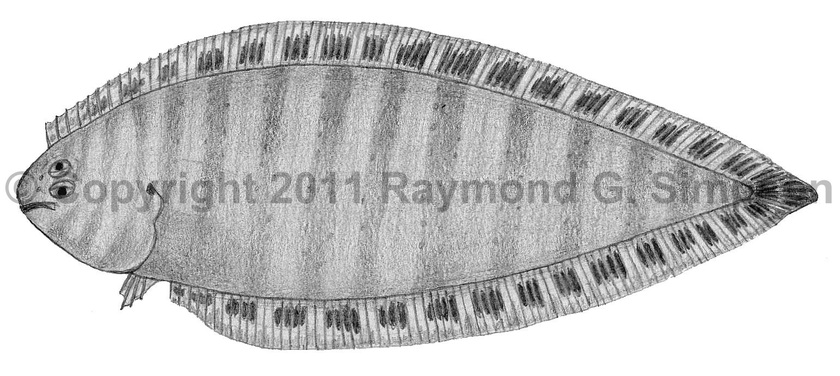
Common Name
Caribbean Tonguefish
Year Described
Munroe, 1991
Identification
Dorsal Fin Rays: 89-96
Anal Fin Rays: 74-80
Pectoral Fin Rays: none
Pelvic Fin Rays: 4
Caudal Fin Rays: 12
Longitudinal Scale Rows: 78-89
Vertebrae: 48-51
Pterygiophore pattern (1st three interneural spaces): 1-4-3
Other diagnostic characters include: pupillary operculum absent, ocular side lower and upper jaw either without teeth or teeth only on the anterior third of jaw, ocular side jaw without fleshy ridge, and blind side of dorsal and anal fin without scales.
Color
Brown to yellow base color with 10-15 narrow dark crossbands (some incomplete). Inner lining of ocular side opercle dark, often showing through on ocular side. Dorsal and anal fins with alternating dark and pale regions, with the exception of the anterior dorsal fin (which is pale) and the caudal fin (which is often dark). Peritoneum unpigmented. Blind side pale without melanophores.
Size
Mature adults from 70-80mm. Maximum length 130mm.
Habitat
A shallow water species (<29m, mostly much shallower) over sand or mud bottoms.
Range Map

Range
Widespread in the Caribbean Sea at scattered continental and insular localities.
References
Munroe, T. A. 1991. Western Atlantic tonguefishes of the Symphurus plagusia complex (Cynoglossidae: Pleuronectiformes), with descriptions of two new species. Fishery Bulletin v. 89: 247-287.
Munroe, T.A. 1998. Systematics and ecology of western Atlantic tonguefishes (Symphurus: Cynoglossidae: Pleuronectiformes). Fish. Bull. 96(1):1-182.
Munroe, T. A. 2003. Bothidae (Pp. 1885-1895), Scophthalmidae (Pp. 1896-1897), Paralichthyidae (Pp. 1898-1921), Poecilopsettidae (Pp. 1922-1923), Achiridae (Pp. 1925-1933), Cynoglossidae (Pp. 1934-1959). In: Carpenter 2003 [ref.27082]. The living marine resources of the Western Central Atlantic v. 3.